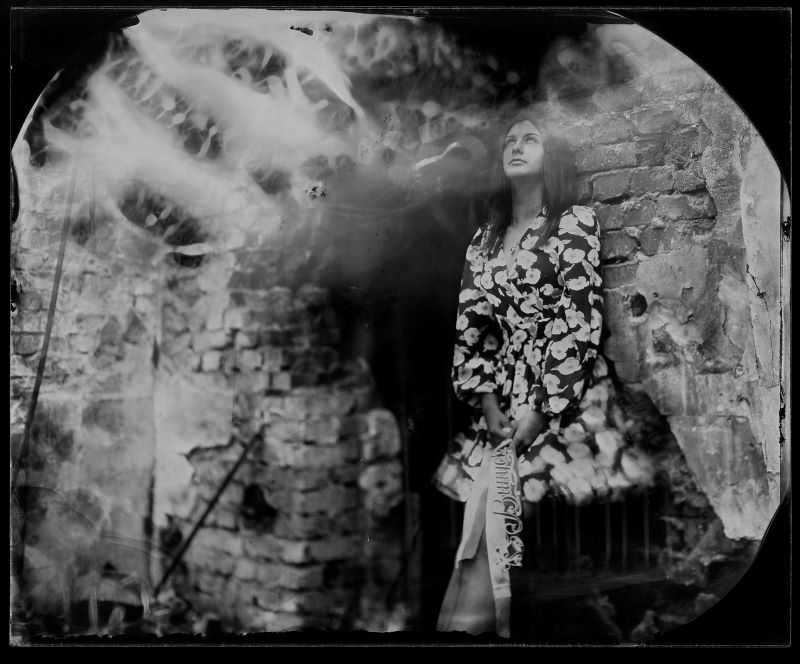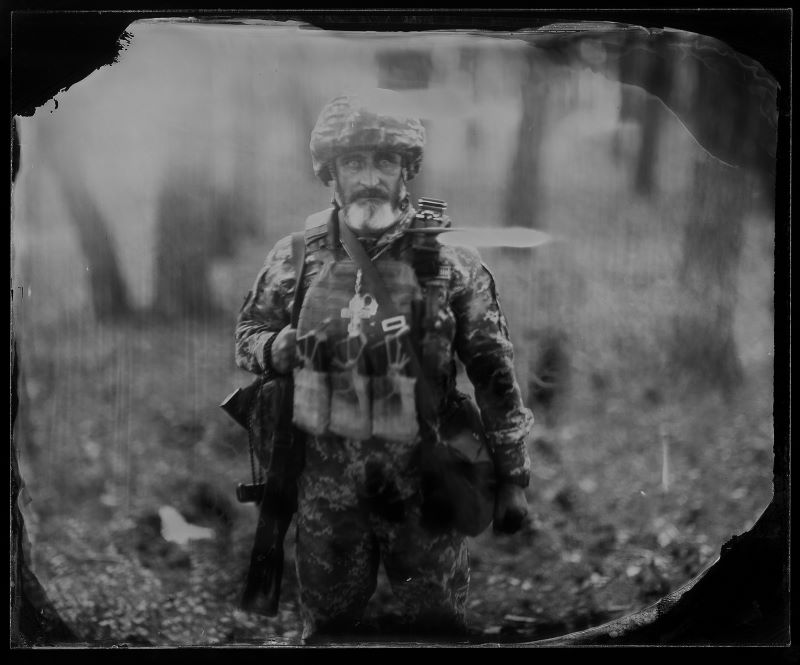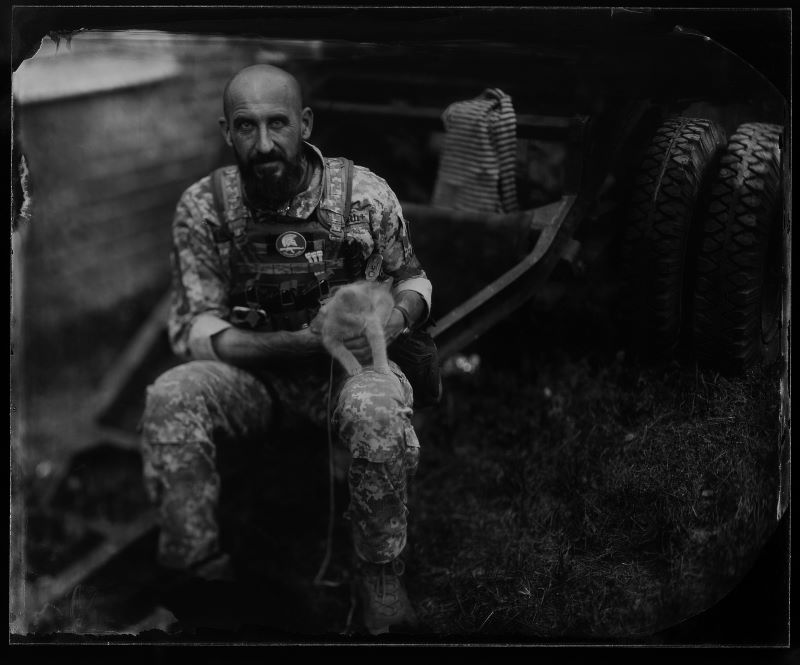Image: (Edward Kaprov) Andrey Kravchenko, 31 years old. callsign Achilles. from Kharkov region. Before the war, he worked as a massage therapist.On the first day of the war, he went to sign up for volunteers, but he was accepted on March 19
Warning. This article contains images of deceased people.
How do you capture War in a photograph? War, by nature, escapes photography. It is too massive, and visceral, and its impacts are too encompassing and traumatic to capture in an image.
But perhaps this is the wrong question. Instead of asking how do we reduce War to a photograph? Maybe the real question is; how do we expand photography to include War?
This is the question that Ukranian-born Israeli documentary photographer Edward Kaprov addressed in his series Last War.
Last War captures the brutal reality of the Russian invasion of Ukraine and the ongoing impact on the Ukrainian people. What sets Kaprov’s images apart from other representations of this conflict is his use of the 19th-century wet collodion process (Ambrotype) – the medium used by Roger Fenton in Crimea in 1855 to capture the first war photographs in history.

Image: (Edward Kaprov) Kids in front of ruins of the sanitary station. Lisichansk. Sievierodonetsk area of the Luhansk District 15.6.22

Image: (Edward Kaprov) Mortars at thier base in the Slavyansk region. 14.6.22
Edward was born in Chelyabinsk, in the Ural district, where he spent most of his adolescence. He and his family then emigrated to Israel, but most of Edward’s family still live in Ukraine, though many have now been evacuated.
After moving to Israel, Edward served in the Israeli armed forces, where his interest in the intersections between War and photography began. In fact, War has always been central to Edward’s life, as he explains;
“I was born and raised in the USSR, where WWII (“Great Patriotic War”) was a “sacred cow”. It was the personification of good and evil. I grew up with war movies and books, heroic deeds and my grandmother’s stories of the famine she endured. Like other boys, probably, I was a little sad that I missed that time and would not be able to accomplish my feat. I couldn’t imagine that I would have to witness an event comparable in scale to that tragedy during my lifetime. Of course, I couldn’t think that Russia would become a new symbol of absolute evil.”
On March 29th, Edward travelled to Kharkiv. But, of course, the reality was nothing like he imagined as a kid.
“During my first trip to Ukraine, I became an eyewitness to this devastating and horrifying disaster. It was then I decided to shoot the Last War using the first photography technique. To juxtapose past and present. I wanted to evoke the first documented War, fought in the same region almost two centuries ago – the Crimean War.”

Image: (Edward Kaprov) Batya (Dad) amazed me with his look and stature and noble posture, in his quiet and calm language in beautiful Ukrainian…one would think he was a hereditary officer. But it turned out that he was a village guy and a father of 8 kids.

Image: (Edward Kaprov) Alexander Koplik, lieutenant colonel. The task of the unit is to search for the dead bodies of the Russian military for the purpose of exchange and establishing the fact that they died on the territory of Ukraine to collect evidence for the Hague court. His assistants Yuri and Vladimir from the village of Malaya Rogan near Kharkov
During Edward’s second trip to Ukraine, he started to employ the anachronistic technique.
The process is involved and laborious. One must apply a photosensitive material on a specially processed glass before taking a photograph. After the exposure, you immediately have to develop and fix the image on the glass; a positive of the image then appears on the specialised glass. This means that each image is unique, with no possibility of duplication. The photographer has to be the shooter, editor and developer. Not ideal for a photographer on the front lines.
“There were plenty of logistical difficulties”, Edward told me, “Finding fuel, water, cooling the chemicals, the price of the materials, injuries, negotiations and so on. It was especially challenging to do it all alone”.
Edward secured a Ford Transit in Germany, serving as his darkroom-on-wheels for processing his ambrotypes. Edward drove his converted minibus, filled with chemicals and carefully prepared glass slides, to the front line in Kharkiv.

Image: (Edward Kaprov) Dasha from Ivano-Frankivsk. She arrived in Kharkov a few days before the start of the war. She Came to enter theatre school. Today, on her “last call,” she decided to visit the bombed-out building of the school 134.

Image: (Edward Kaprov) Chaplain of 226 Separate battalion, Kharkiv. 8.6.22
Cumbersome though it might have been, the result is a haunting series of photographs evoking an ineffable tension between past and present, history and future.
“I believe that the different visual approach will grab the attention of the audience directing their focus unflinchingly to the conflict.” Edward continues, “Encourage them to look, think and compare it to human history.”
Unlike other war imagery of modern conflicts that are arresting for their immediate recount of violence, Edward’s ambrotypes are impactful differently. Their effect is glacial, with the image’s significance burgeoning only once the viewer realises they are witnessing a modern conflict.
Each ambrotype calls for sustained scrutiny since it’s only after a moment of attention that one begins to notice the modern technology and costumes of the subjects in the frame, betraying the historical medium.
Edward’s images are at once timely and timeless.

Image: (Edward Kaprov) Denis, from teams of workers from the Kharkiv region. For 300 hryvnias a day, they dismantle the rubble of the bombed-out school 134 on Shevcheno Street. Kharkiv.

Image: (Edward Kaprov) Sergei hung out with the kitten that was brought from “zero”. The kitten was hiding with him from the artillery fire.
The staged stillness of Edward’s photographs adds another point of contrast to modern conflict imagery.
The wet collodion process is not suited to capturing action, the exposure takes several seconds, and you need to develop the image almost immediately. The process lends itself excellently to photographing the destructive aftermath of War, a common subgenre of conflict photography that captures the eeriness of destroyed buildings and abandoned towns. Despite this, Edward chose only to photograph human subjects.
“I believe you see the true scale of the War through the human eyes. I’ve got a lot of support from people I’ve photographed. They believed in the power of this work and its historical aspect for the future. Actually, this technique gave me special access to the people I photographed. They wanted to be a part of this.”
There is an unheard exchange behind every image in the Last War series; a discussion in which Edward introduced himself to the soldiers or civilians, explained his project and asked them to pose for his ‘fancy camera’.
It’s a dance between subject and photographer, where the subject has just as much agency as the latter as they stare down the lens. ‘Victims of war’ become ‘people experiencing war’. They are no longer victims of the lens but creators of their own image.
In this way, Edward’s images are war photographs outside of War. His subjects had to pose for the composition, taking a moment of pause from their brutal reality. Their stillness is all the more impactful due to the urgency of their situation – they need to move to survive. And, of course, the stillness of the dead becomes even more charged.
“In this body of work, while I sacrificed a “decisive moment”, I’m trying to catch on fragile glass the face and the timeless tragedy of War. I deliberately want to confuse my audience, make them take a closer look – and realise that the seemingly ‘old’ photos have in fact been taken today. Thus, I’ve tried to close a certain logical circle.”

Image: (Edward Kaprov) Body of Russian soldier found in field near Verhnya Rohan

Image: (Edward Kaprov) A body burnt as a result of shelling of a shopping centre in Kharkov. June 2022
Pictures change, but War never does.
Edward’s images of the Ukrainian people historicise the War, solidifying the ongoing conflict in cultural memory. They are at once a modern document and a historical artefact – taking the visual experience of the War out of our rolling newsfeeds and placing it into unique objects that must be held, considered, and reflected upon.
About the Photographer
Edward Kaprov was born and grew up in the Soviet Union. He came to Israel after his motherland, along with its Utopia, disappeared from the world maps.
“Wandering back and forth from “The Land of Patriarchs” to his Motherland, all issues he is dealing with reflects the nostalgia of high Ideas, that deny real circumstances.”
He is currently working freelance with known magazines in Israel and abroad such as; El Pais, National Geographic, Geo, MasaAher, Menta, and Kommersant.












